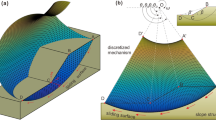Abstract
Slope stability analysis is an enduring research topic in the engineering and academic sectors. Probability-based analysis is the most popular method for evaluating a wide range of natural slope instability risks, but the lack of landslide data limits its application. A new method of regional slope stability analysis is presented that combines spatial analysis and two-dimensional slope analysis. First, a region is divided into slope units based on terrain and hydrology analysis, and the main potential slip sections of slope units are determined. Second, the potential slip surface of each section is determined and stability factors calculated with a two-dimensional slope analysis model. Finally, regional slope stability analysis is determined from the results of slope unit segmentation and slope stability analysis. A loess gully zone in Jintai District, Baoji City, China, constitutes the study area. A topographic map is transformed into a digital elevation model and evaluation zones determined by slope unit segmentation. A 3D geological model is devised from survey, drilling and investigation data. Geological profiles are generated automatically and slope stability analysis performed immediately with the small tool developed herein. Lastly, a map of regional slope assessment is produced. The method proposed combines the two-dimensional limit equilibrium method and spatial analysis, which are the methods usually used in engineering practice. It can provide not only a distribution map of safety factors, but also the scale and location of most dangerous slip surfaces. This study provides a new way to assess the natural slope risk of large areas.












Similar content being viewed by others
References
Cheng Q, Russell H, Sharpe D, Kenny F, Qin P (2001) GIS-based statistical and fractal/multifractal analysis of surface stream patterns in the Oak Ridges Moraine. Comput Geosci 27(5):513–526
Conoscenti C, Di Maggio C, Rotigliano E (2008) GIS analysis to assess landslide susceptibility in a fluvial basin of NW Sicily (Italy). Geomorphology 94(3–4):325–339
Grenon M, Hadjigeorgiou J (2010) Integrated structural stability analysis for preliminary open pit design. Int J Rock Mech Min Sci 47(3):450–460
Guzzetti F (2000) Landslide fatalities and the evaluation of landslide risk in Italy. Eng Geol 58(2):89–107
Jia N, Mitani Y, Xie M, Djamaluddin I (2012) Shallow landslide hazard assessment using a three-dimensional deterministic model in a mountainous area. Comput Geotech 45:1–10
Li XP, Zhou SP (2012) Application and Research of GIS-based Wushan County Slope Stability Evaluation Information System. Procedia Engineering 29:2296–2302
Listo FDLR, Carvalho Vieira B (2012) Mapping of risk and susceptibility of shallow landslide in the city of São Paulo. Brazil. Geomorphology 169–170:30–44
Meisina C, Scarabelli S (2007) A comparative analysis of terrain stability models for predicting shallow landslides in colluvial soils. Geomorphology 87(3):207–223
Pan M, Fang Y, Qu HG (2007) Discussion on Several Foundational Issues in Three- Dimensional Geological Modeling. Geography and Geo-Information Science 23(3):1–5
Perotto-Baldiviezo HL, Thurow TL, Smith CT, Fisher RF, Wu XB (2003) GIS-based spatial analysis and modeling for landslide hazard assessment in steeplands, southern Honduras. Agric Ecosyst Environ 103(1):165–176
Rowbotham DN, Dudycha D (1998) GIS modelling of slope stability in Phewa Tal watershed. Nepal. Geomorphology 26(1–3):151–170
Saldivar-Sali A, Einstein HH (2007) A Landslide Risk Rating System for Baguio. Philippines. Engineering Geology 91(2–4):85–99
Tarolli P, Borga M, Chang K, Chiang S (2011) Modeling shallow landsliding susceptibility by incorporating heavy rainfall statistical properties. Geomorphology 133(3–4):199–211
Xie M, Esaki T, Cai M (2004) A GIS-based method for locating the critical 3D slip surface in a slope. Comput Geotech 31(4):267–277
Xie M, Esaki T, Qiu C, Wang C (2006) Geographical information system-based computational implementation and application of spatial three-dimensional slope stability analysis. Comput Geotech 33(4–5):260–274
Xu C, Dai F, Xu X, Lee YH (2012) GIS-based support vector machine modeling of earthquake-triggered landslide susceptibility in the Jianjiang River watershed, China. Geomorphology 145–146:70–80
Zolfaghari A, Heath AC (2008) A GIS application for assessing landslide hazard over a large area. Comput Geotech 35(2):278–285
Acknowledgments
The authors are grateful for the financial support from the China Natural Science Foundation under the grant nos. 41202187 and 41372269.
Author information
Authors and Affiliations
Corresponding author
Rights and permissions
About this article
Cite this article
Gu, T., Wang, J., Fu, X. et al. GIS and limit equilibrium in the assessment of regional slope stability and mapping of landslide susceptibility. Bull Eng Geol Environ 74, 1105–1115 (2015). https://doi.org/10.1007/s10064-014-0689-2
Received:
Accepted:
Published:
Issue Date:
DOI: https://doi.org/10.1007/s10064-014-0689-2




